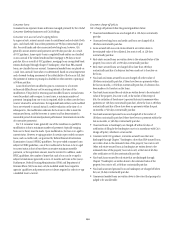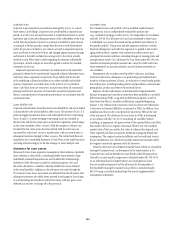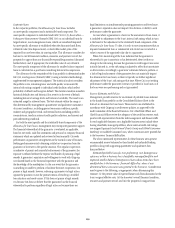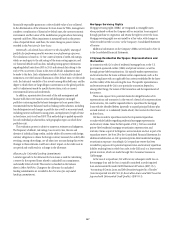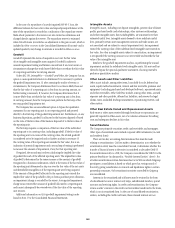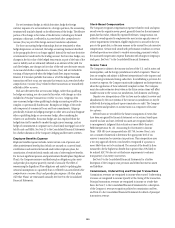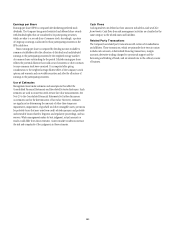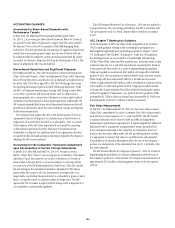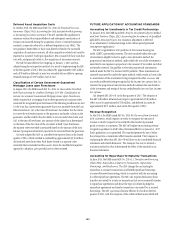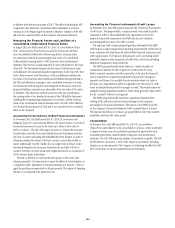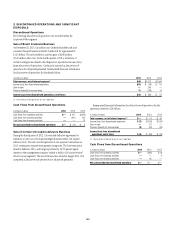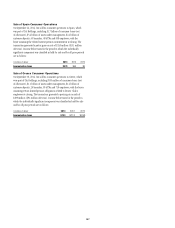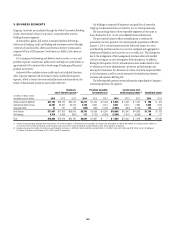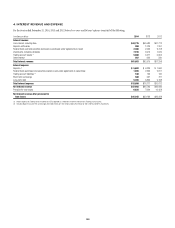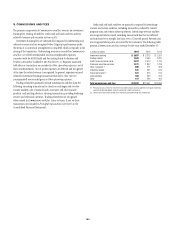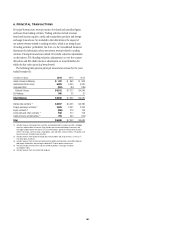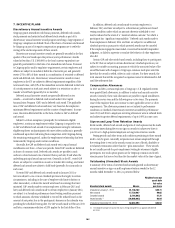Citibank 2014 Annual Report Download - page 169
Download and view the complete annual report
Please find page 169 of the 2014 Citibank annual report below. You can navigate through the pages in the report by either clicking on the pages listed below, or by using the keyword search tool below to find specific information within the annual report.152
ACCOUNTING CHANGES
Accounting for Share-Based Payments with
Performance Targets
In June 2014, the FASB issued Accounting Standards Update (ASU)
No. 2014-12, Accounting for Share-Based Payments When the Terms of
an Award Provide That a Performance Target Could Be Achieved after
the Requisite Service Period (a consensus of the FASB Emerging Issues
Task Force). The ASU prescribes the accounting to be applied to share-based
awards that contain performance targets, the outcome of which will only
be confirmed after the employee’s service period associated with the award
has ended. Citi elected to adopt this ASU from the third quarter of 2014. The
impact of adopting the ASU was not material.
Discontinued Operations and Significant Disposals
The FASB issued ASU No. 2014-08, Presentation of Financial Statements
(Topic 810) and Property, Plant, and Equipment (Topic 360), Reporting
Discontinued Operations and Disclosures of Disposals of Components of
an Entity (ASU 2014-08) in April 2014. ASU 2014-08 changes the criteria
for reporting discontinued operations while enhancing disclosures. Under
the ASU, only disposals representing a strategic shift having a major effect
on an entity’s operations and financial results, such as a disposal of a
major geographic area, a major line of business or a major equity method
investment, may be presented as discontinued operations. Additionally, the
ASU requires expanded disclosures about discontinued operations that will
provide more information about the assets, liabilities, income and expenses
of discontinued operations.
The Company early-adopted the ASU in the second quarter of 2014 on
a prospective basis for all disposals (or classifications as held-for-sale) of
components of an entity that occurred on or after April 1, 2014. As a result
of the adoption of the ASU, fewer disposals will now qualify for reporting
as discontinued operations; however, disclosure of the pretax income
attributable to a disposal of a significant part of an organization that does
not qualify for discontinued operations reporting is required. The impact of
adopting the ASU was not material.
Accounting for the Cumulative Translation Adjustment
upon Derecognition of Certain Foreign Subsidiaries
In March 2013, the FASB issued ASU No. 2013-05, Foreign Currency
Matters (Topic 830): Parent’s Accounting for the Cumulative Translation
Adjustment upon Derecognition of Certain Subsidiaries or Groups of
Assets within a Foreign Entity or of an Investment in a Foreign Entity
(a consensus of the FASB Emerging Issues Task Force). This ASU clarifies
the accounting for the cumulative translation adjustment (CTA) when a
parent either sells a part or all of its investment in a foreign entity or no
longer holds a controlling financial interest in a subsidiary or group of assets
that is a nonprofit activity or a business within a foreign entity. The ASU
requires the CTA to remain in equity until the foreign entity is disposed of or
it is completely or substantially liquidated.
This ASU became effective for Citi on January 1, 2014 and was applied on
a prospective basis. The accounting prescribed in this ASU is consistent with
Citi’s prior practice and, as a result, adoption did not result in any impact
to Citi.
OCC Chapter 7 Bankruptcy Guidance
In the third quarter of 2012, the Office of the Comptroller of the Currency
(OCC) issued guidance relating to the accounting for mortgage loans
discharged through bankruptcy proceedings pursuant to Chapter 7 of the
U.S. Bankruptcy Code (Chapter 7 bankruptcy). Under this OCC guidance,
the discharged loans are accounted for as troubled debt restructurings
(TDRs). These TDRs, other than FHA-insured loans, are written down to their
collateral value less cost to sell. FHA-insured loans are reserved for, based on
a discounted cash flow model. As a result of implementing this guidance,
Citigroup recorded an incremental $635 million of charge-offs in the third
quarter of 2012, the vast majority of which related to loans that were current.
These charge-offs were substantially offset by a related loan loss reserve
release of approximately $600 million, with a net reduction in pretax income
of $35 million. In the fourth quarter of 2012, Citigroup recorded a benefit
to charge-offs of approximately $40 million related to finalizing the impact
of this OCC guidance. Furthermore, as a result of this OCC guidance, TDRs
increased by $1.7 billion and non-accrual loans increased by $1.5 billion in
the third quarter of 2012 ($1.3 billion of which was current).
Fair Value Measurement
In May 2011, the FASB issued ASU No. 2011-04, Fair Value Measurement
(Topic 820): Amendments to Achieve Common Fair Value Measurement
and Disclosure Requirements in U.S. GAAP and IFRS. The ASU created
a common definition of fair value for GAAP and IFRS and aligned the
measurement and disclosure requirements. It required significant additional
disclosures both of a qualitative and quantitative nature, particularly for
those instruments measured at fair value that are classified in Level 3 of
the fair value hierarchy. Additionally, the ASU provided guidance on when
it is appropriate to measure fair value on a portfolio basis and expanded
the prohibition on valuation adjustments where the size of the Company’s
position is a characteristic of the adjustment from Level 1 to all levels of the
fair value hierarchy.
The ASU became effective for Citigroup on January 1, 2012. As a result of
implementing the prohibition on valuation adjustments where the size of
the Company’s position is a characteristic, the Company released reserves of
approximately $125 million, increasing pretax income in the first quarter
of 2012.




